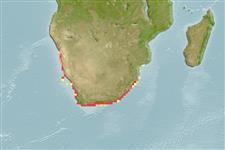Teleostei (teleosts) >
Eupercaria/misc (Various families in series Eupercaria) >
Sparidae (Porgies)
Etymology: Cymatoceps: Greek, kyma, -atos = wave, swelling, bump (Ref. 45335).
More on author: Castelnau.
Environment: milieu / climate zone / depth range / distribution range
Ecology
Marine; brackish; demersal; depth range 1 - 80 m (Ref. 3507). Subtropical; 22°S - 35°S
Western Indian Ocean: Natal to the Cape in South Africa.
Length at first maturity / Size / Weight / Age
Maturity: Lm ?, range 53 - ? cm
Max length : 150 cm TL male/unsexed; (Ref. 3507); max. published weight: 34.4 kg (Ref. 40637)
Inhabits shallow, rocky coastal areas to 80 m depth. Rarely enters estuaries. Feeds on crabs, crayfish, sea urchins and other hard-shelled animals (Ref. 3670). Takes almost any bait (Ref. 3198). Important food fish. Head considered a delicacy in some areas (Ref. 3198). It is parasitised by the monogenean Anoplodiscus cirrusspiralis on the fins and body surface (Ref. 124057).
Life cycle and mating behavior
Maturity | Reproduction | Spawning | Eggs | Fecundity | Larvae
Bauchot, M.-L. and M.M. Smith, 1984. Sparidae. In W. Fischer and G. Bianchi (eds.) FAO species identification sheets for fishery purposes. Western Indian Ocean (Fishing Area 51). volume 4. [var. pag.] FAO, Rome. (Ref. 3507)
IUCN Red List Status (Ref. 130435: Version 2025-1)
Threat to humans
Harmless
Human uses
Fisheries: commercial; gamefish: yes
Tools
Special reports
Download XML
Internet sources
Estimates based on models
Preferred temperature (Ref.
123201): 16.7 - 26, mean 23.9 °C (based on 36 cells).
Phylogenetic diversity index (Ref.
82804): PD
50 = 1.0000 [Uniqueness, from 0.5 = low to 2.0 = high].
Bayesian length-weight: a=0.01514 (0.00830 - 0.02759), b=3.06 (2.91 - 3.21), in cm total length, based on LWR estimates for this species & (Sub)family-body (Ref.
93245).
Trophic level (Ref.
69278): 3.6 ±0.40 se; based on food items.
Resilience (Ref.
120179): Very Low, minimum population doubling time more than 14 years (K=0.05; tmax=45).
Fishing Vulnerability (Ref.
59153): High to very high vulnerability (74 of 100).
🛈
Nutrients (Ref.
124155): Calcium = 35.5 [18.7, 71.4] mg/100g; Iron = 0.796 [0.436, 1.497] mg/100g; Protein = 19.9 [18.9, 21.0] %; Omega3 = 0.312 [0.189, 0.521] g/100g; Selenium = 32.4 [14.4, 64.5] μg/100g; VitaminA = 7.53 [2.05, 23.50] μg/100g; Zinc = 0.739 [0.512, 1.054] mg/100g (wet weight);
